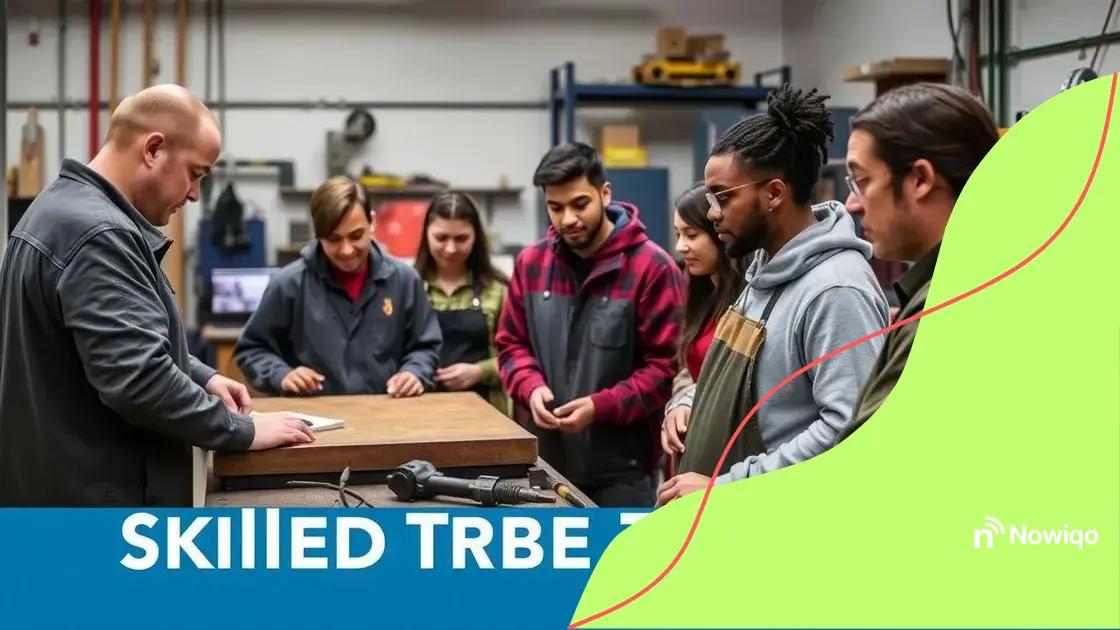Skilled trades gap solutions you need to know

Anúncios
The skilled trades gap solutions involve advancing training programs, utilizing technology for recruitment, and fostering partnerships between businesses and educational institutions to meet workforce demands effectively.
Skilled trades gap solutions are becoming increasingly important as industries face shortages in essential roles. Have you noticed the growing demand for skilled labor in your community? Let’s explore how to tackle this pressing issue together.
Anúncios
Understanding the skilled trades gap
Understanding the skilled trades gap is crucial as industries across the globe face a significant shortage of qualified workers. This gap can affect various sectors, from construction to healthcare, and understanding its implications can help us find solutions.
Factors Contributing to the Skilled Trades Gap
Several key factors contribute to this growing gap. First, many experienced workers are retiring, leaving behind a void that is hard to fill. Additionally, younger generations often overlook trades as viable career options. Schools may not adequately promote these opportunities, which can result in a lack of prepared individuals.
Impact of the Gap
The skilled trades gap can have serious repercussions for the economy. Without enough skilled labor, projects may slow down or even be halted, impacting productivity and growth. As businesses struggle to find talent, they may face increased labor costs or turn to outsourcing, which can harm local economies.
Anúncios
- Economic growth can stall due to workforce shortages.
- Increased labor costs affect project budgets.
- Local communities may miss out on job opportunities.
- The quality of work may decline if inexperienced workers fill the gap.
Addressing this gap requires a coordinated effort from various stakeholders, including education systems, businesses, and government programs. By creating awareness about the importance of skilled trades, more individuals may consider these careers.
Benefits of Closing the Gap
Closing the skilled trades gap not only benefits businesses but also supports economic growth. A robust workforce can lead to improved innovation, higher-quality workmanship, and even lower production costs.
Ensuring that the next generation understands the potential of skilled trades opens doors to fulfilling careers. With proper training and support, we can prepare future workers to step into available roles. Initiatives such as apprenticeships and vocational training programs are essential in bridging this gap.
Impact of the skilled trades gap on the economy
The impact of the skilled trades gap on the economy is significant and multi-faceted. A shortage of skilled workers can lead to several challenges for businesses and communities alike.
Challenges Faced by Businesses
Many industries struggle to find qualified workers to fill essential roles. This shortage can result in delayed projects, increased costs, and a loss of potential revenue. As demands rise, companies may need to overextend their resources to compensate for the lack of labor.
- Projects may take longer to complete, affecting timelines.
- Higher wages are often necessary to attract available talent.
- Business growth can stagnate due to a lack of workforce.
- Quality of work may decline if inexperienced workers are hired.
Such impacts do not only affect individual businesses but ripple through the economy. When companies can’t find the labor they need, it affects supply chains and economic stability.
Broader Economic Consequences
The skilled trades gap poses a threat to local economies. Increased unemployment rates can result when companies scale back operations. Communities that rely on skilled trades for growth face potential decline, as fewer jobs can lead to reduced spending and investment.
Moreover, the inability to fill skilled positions can drive prices up for goods and services. When demand outstrips supply, consumers eventually bear the burden.
The Need for Solutions
Addressing the impact of the skilled trades gap is necessary for both businesses and communities. By investing in training programs and promoting awareness of trades as viable career paths, we can start to bridge this gap. Collaboration between educational institutions and employers can ensure that future workers are appropriately trained and ready for the demands of the job market.
With better workforce planning, communities can thrive while ensuring that industries have the labor they need to grow and thrive.
Training programs for skilled trades

Training programs for skilled trades play a vital role in preparing the workforce for demanding jobs in various industries. These programs aim to equip individuals with the necessary skills and knowledge to succeed in their chosen trades.
Types of Training Programs
There are various paths for individuals interested in skilled trades. Many programs offer hands-on training and classroom instruction. Options include traditional apprenticeships, technical schools, and community college courses. Each of these pathways provides unique benefits that cater to different learning styles.
- Apprenticeships combine on-the-job training with classroom instruction.
- Technical schools focus on specialized trade skills.
- Community colleges offer broader programs, including certifications.
- Online courses are becoming popular for flexible learning.
These training programs help bridge the skilled labor gap by preparing learners to enter the workforce with confidence. With practical experience, graduates can move into well-paying jobs more easily than those without proper training.
Benefits of Skilled Trades Training
Participating in skilled trades training has several advantages. First, trained individuals often command higher wages than those in unskilled jobs. Additionally, there is a high demand for skilled workers, which can lead to job security and benefits.
Moreover, many trade programs emphasize safety and best practices, ensuring that workers can perform their jobs effectively while minimizing workplace hazards. This focus on safety is essential in today’s job market, where regulations are stringent.
Addressing the Skills Gap
By investing in training programs, communities can effectively address the skills gap in the labor market. Businesses that collaborate with educational institutions can create a pipeline of skilled workers ready to fill available positions. This partnership not only benefits the employers but also supports local economies.
Encouraging more individuals to consider careers in skilled trades can elevate the status of these professions, making them attractive options for students and job seekers alike.
Innovative solutions for workforce shortages
Innovative solutions for workforce shortages are essential in addressing the challenges faced by industries today. As the skilled trades gap widens, companies are seeking creative strategies to attract and retain talent.
Utilizing Technology for Recruitment
Many companies are turning to technology to streamline their recruitment processes. Online platforms and job boards allow employers to reach a larger audience. Social media campaigns targeting younger generations can also effectively attract potential candidates.
- Virtual job fairs connect employers and job seekers remotely.
- Online training resources make skills acquisition more accessible.
- Gamification in recruitment enhances engagement.
- AI tools can match candidates with suitable job openings.
These technological advances make it easier for businesses to find the right fit for their open positions. By leveraging digital tools, companies can reduce hiring time and improve the quality of candidates.
Partnerships with Educational Institutions
Collaboration between businesses and educational institutions is another innovative solution. By creating partnerships, companies can help shape training programs that reflect current industry needs. This ensures that students are prepared for real-world challenges upon graduation.
Moreover, internships and apprenticeship programs provide students with hands-on experience while fulfilling the workforce’s demands. These collaborations not only benefit students but also create a pipeline of skilled workers for companies.
Flexible Work Arrangements
Offering flexible work arrangements can also help attract talent in a competitive job market. Many workers today value work-life balance. Employers who provide options such as remote work or flexible hours often see higher job satisfaction and retention rates.
By adapting to the changing preferences of the workforce, companies can maintain a loyal and motivated team, ultimately leading to increased productivity.
In conclusion, addressing workforce shortages requires innovative approaches. By utilizing technology, forging partnerships, and offering flexibility, businesses can secure a strong workforce that meets the challenges of the future.
The future of skilled trades in the job market
The future of skilled trades in the job market looks promising as industries continue to evolve and adapt to new technologies. As the demand for skilled workers grows, these trades are becoming more relevant than ever.
Emerging Technologies
With the advent of new technologies, many skilled trades are integrating innovative tools and techniques. For example, electricians are increasingly using smart technology in homes and businesses. This shift creates new opportunities for those entering the field.
- Automation in manufacturing is redefining production roles.
- Renewable energy is creating jobs in solar and wind industries.
- Plumbing is evolving with new eco-friendly practices.
- Construction technology is advancing with tools like drones and 3D printing.
As these technologies emerge, training programs must adapt, ensuring that new workers are familiar with the tools and methods they will encounter.
Increased Career Opportunities
The skilled trades are experiencing a surge in demand for qualified workers. Many industries are struggling to find personnel with the necessary skills, leading to more job opportunities. Positions in construction, plumbing, and electrical work often come with competitive salaries and benefits.
Additionally, as skilled workers retire, it opens up even more opportunities for young individuals looking to enter the workforce. Career pathways are expanding, making the trades more accessible to those seeking stable employment.
Promotion of Skilled Trades
There is a growing recognition of the importance of skilled trades in society. Schools and community organizations are starting to promote these careers more actively. Programs that introduce students to trades can spark interest at an early age.
Furthermore, public campaigns highlighting the benefits of skilled trades help change perceptions, showcasing them as viable and rewarding career options. This shift can encourage more individuals to consider paths in the skilled trades, ultimately enriching the workforce.
FAQ – Frequently Asked Questions about Skilled Trades
What are skilled trades?
Skilled trades refer to occupations that require specific training and expertise, such as electricians, plumbers, and carpenters.
How is the demand for skilled trades changing?
The demand for skilled trades is increasing due to workforce shortages and the emergence of new technologies in various industries.
What types of training programs are available for skilled trades?
Training programs include apprenticeships, technical schools, and community college courses that focus on hands-on experience and practical skills.
How can I promote a career in skilled trades to young people?
Promoting skilled trades can be done through school programs, community outreach, and highlighting the benefits such as job security and good pay.